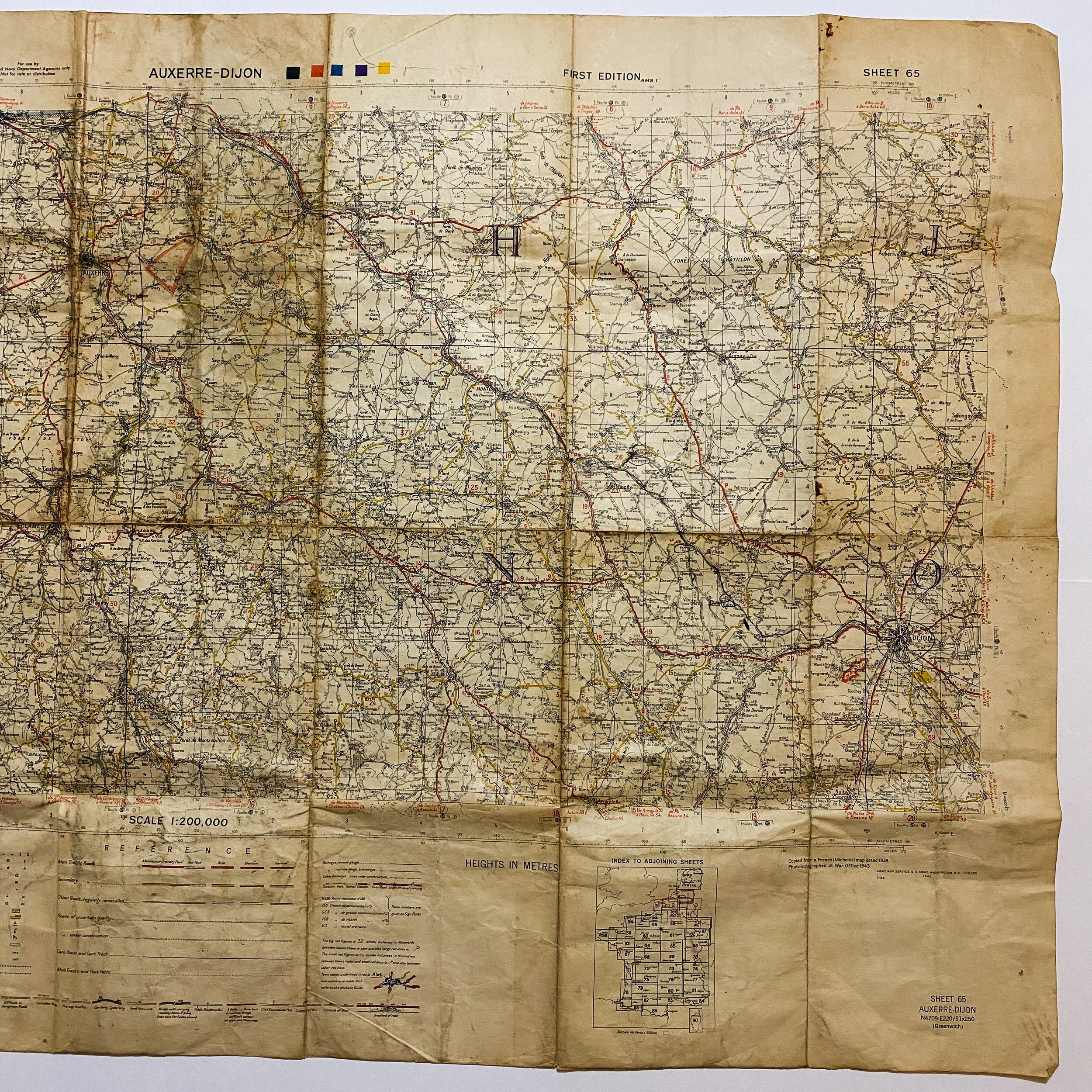Original U.S. WWII Operation Dragoon Map of France - Dijon 1943















Original U.S. WWII Operation Dragoon Map of France - Dijon 1943
This is a heavily used map that comes from the estate of a WWII 3rd Army veteran that led members of his squad along with Lt. Gen. George Patton’s U.S. Third Army while advancing east toward the border with Germany. This map shows many towns and city liberated by the US after the D-Day landing as the Allies drove 400 miles into France in three weeks and liberated 10,000 square miles of French territory while inflicting 143,250 German casualties. This is an extremely rare 1943 dated, 1st edition, 3rd Army France war department map. This map is very large and in very sturdy condition. It shows grid sectors marked G,M,H,N,J, and O. Information was constructed using French aid maps from 1939 and were photo-lithographed by the US war office in 1943. This map shows operational marked maps of movement locations and other unknown markings.
France’s Second D-Day - Operation Dragoon:
By September 7, a combat patrol made contact with the French 2nd Armored Division operating west of Dijon. The French, in collaboration with Lt. Gen. George Patton’s U.S. Third Army, were advancing east toward the border with Germany. With the full link up of Allied armies completed by September 10, the Seventh Army turned northeast toward Strasbourg. The drive to the German frontier began, and Operation Dragoon ended. Over the course of the offensive, the Allies drove 400 miles into France in three weeks and liberated 10,000 square miles of French territory while inflicting 143,250 German casualties. Although launched with reluctant British participation, the campaign through southern France provided crucial support to the main Allied thrust against Germany, and remains one of the most successful–and often overlooked–operations of World War II.
Operation Dragoon (initially Operation Anvil) was the code name for the Allied invasion of Southern Franceon 15 August 1944. The operation was initially planned to be executed in conjunction with Operation Overlord, the Allied landing in Normandy, but the lack of available resources led to a cancellation of the second landing. By July 1944 the landing was reconsidered, as the clogged-up ports in Normandy did not have the capacity to adequately supply the Allied forces. Concurrently, the French High Command pushed for a revival of the operation that would include large numbers of French troops. As a result, the operation was finally approved in July to be executed in August.
Devers' headquarters remained subordinate to AFHQ during the invasion and in the weeks immediately afterwards while operational control of the troops on the ground resided with Patch until his forces linked near Dijon, France with Twelfth United States Army Group's Third Army advancing from the west after breaking out of the Normandy beachhead. At this time, on 15 September, Devers' headquarters was designated Sixth Army Group to take operational control of Seventh Army and French Army B and came under the overall command of General Dwight D. Eisenhower, the Supreme Commander at SHAEF (Supreme Headquarters, Allied Expeditionary Forces).
Hindered by total Allied air superiority and a large-scale uprising by the French Resistance, the weak German forces were swiftly defeated. The Germans withdrew to the north through the Rhône valley, to establish a stable defense line at Dijon. Allied mobile units were able to overtake the Germans and partially block their route at the town of Montélimar. The ensuing battle led to a stalemate, with neither side able to achieve a decisive breakthrough, until the Germans were finally able to complete their withdrawal and retreat from the town. While the Germans were retreating, the French managed to capture the important ports of Marseille and Toulon, putting them into operation soon after.
The Germans were not able to hold Dijon and ordered a complete withdrawal from Southern France. Army Group G retreated further north, pursued by Allied forces. The fighting ultimately came to a stop at the Vosges mountains, where Army Group G was finally able to establish a stable defense line. After meeting with the Allied units from Operation Overlord, the Allied forces were in need of reorganizing and, facing stiffened German resistance, the offensive was halted on 14 September. Operation Dragoon was considered a success by the Allies. It enabled them to liberate most of Southern France in a time span of only four weeks, while inflicting heavy casualties on the German forces, although a substantial part of the best German units were able to escape. The captured French ports were put into operation, allowing the Allies to solve their supply problems soon after.